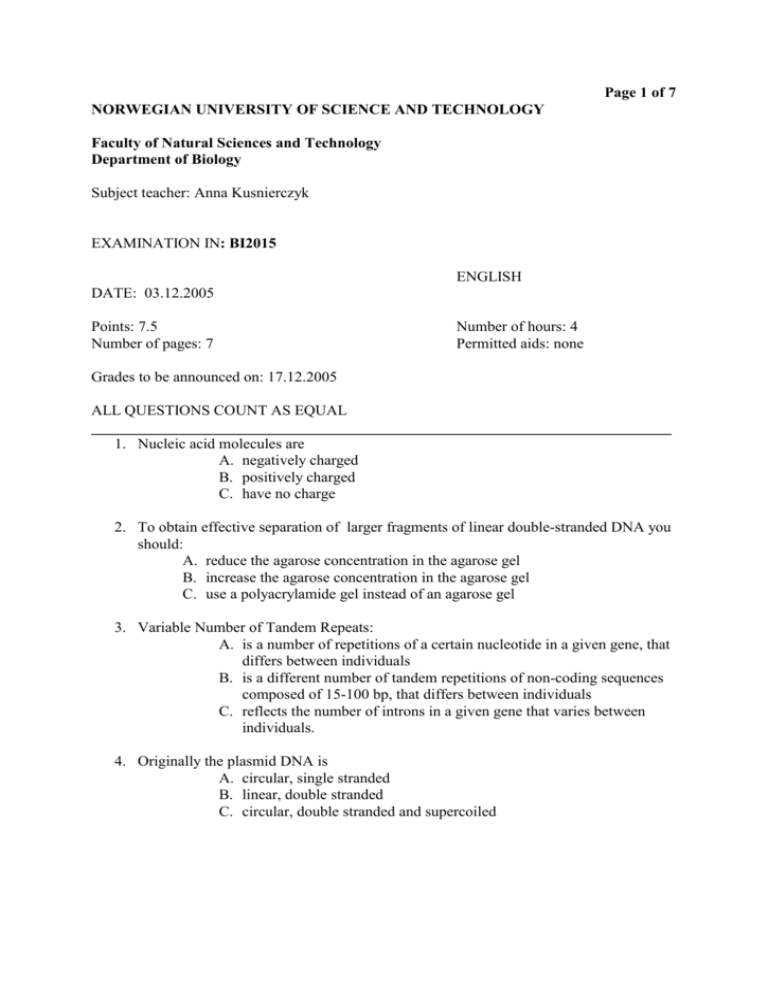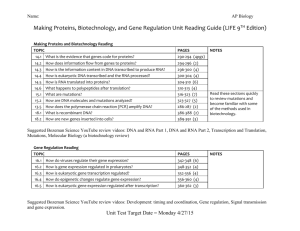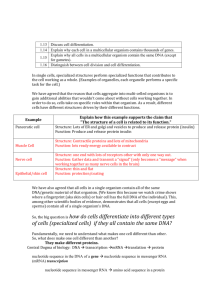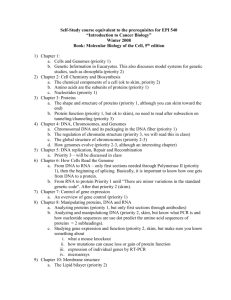NORWEGIAN UNIVERSITY OF SCIENCE AND TECHNOLOGY
advertisement

Page 1 of 7 NORWEGIAN UNIVERSITY OF SCIENCE AND TECHNOLOGY Faculty of Natural Sciences and Technology Department of Biology Subject teacher: Anna Kusnierczyk EXAMINATION IN: BI2015 ENGLISH DATE: 03.12.2005 Points: 7.5 Number of pages: 7 Number of hours: 4 Permitted aids: none Grades to be announced on: 17.12.2005 ALL QUESTIONS COUNT AS EQUAL ___________________________________________________________________________ 1. Nucleic acid molecules are A. negatively charged B. positively charged C. have no charge 2. To obtain effective separation of larger fragments of linear double-stranded DNA you should: A. reduce the agarose concentration in the agarose gel B. increase the agarose concentration in the agarose gel C. use a polyacrylamide gel instead of an agarose gel 3. Variable Number of Tandem Repeats: A. is a number of repetitions of a certain nucleotide in a given gene, that differs between individuals B. is a different number of tandem repetitions of non-coding sequences composed of 15-100 bp, that differs between individuals C. reflects the number of introns in a given gene that varies between individuals. 4. Originally the plasmid DNA is A. circular, single stranded B. linear, double stranded C. circular, double stranded and supercoiled 5. Bacterial competence is A. the direct transfer of genes in bacteria by cell to cell contact B. gene transfer mediated by bacteriophage infection C. the ability of a bacterial cells to take up “naked” DNA from its surroundings 6. During the laboratory experiment with GUS staining, we studied a transgenic plant expressing a TGG1promotorGUS contstruct. After removal of chlorophyll we could observe a blue colour in both stomata and veins. From that observation the following conclusion can be drawn: A. GUS gene driven by TGG1 promotor is activated in stomata and veins by switching on the transcriptional signals and β-Dglucuronidase is produced. B. fusion protein of TGG1 gene product and GUS gene product is produced and gives the blue colour to both stomata and veins C. glucosinolates are produced in stomata and veins 7. Imagine that we have a vector and a fragment DNA which have been cut with the same restriction enzymes and that we want to ligate the two together. What happens if we remove the 5’-phosphate groups by CIP (calf intestinal phosphatase treatment) of the vector to be ligated, but not from the DNA fragment? A. the ligation will not be possible at all B. the normal ligation will be possible only at the two nicks were the 5’phosphate group is supplied by the insert; the other two nicks cannot be repaired but the junction will be stable enough to hold the two strands together C. the ligation will proceed as usual 8. In the transgenic plants expressing GFP5ER, GFP is localized to ER structures. The reason for that is that: A. the GFP in this construct is modified in such a way that it contains an N-terminal signal peptide ensuring secretion and retention of the protein within the lumen of the ER B. every protein that is foreign to the cell will be localized to ER C. the actin binding domain of mouse talin attached to GFP is responsible for the transport of the GFP protein to the ER lumen 9. During the isolation of DNA we raise pH to ~12 and then decrease it in order to A. be able to separate the chromosomal and plasmid DNA B. solubilise the phospholipids and protein components of cell membrane C. inhibit DNases 10. For PCR we use Taq polymerase (from T. aquaticus) because: A. it is cheaper than other polymerases B. it is the only one, which can be produced in laboratory conditions C. it is stable at high temperatures 11. What kind of procedure has to be performed to transform permanently Arabidopsis thaliana plant? A. the flowers have to be submerged in a solution containing transformed bacteria B. the seeds has to be submerged in a solution containing transformed bacteria C. transformed bacteria have to be introduced into soil, in which the plant grows 12. For protoplast isolation A. transgenic plants must be used B. at least 0.5g of plant material must be used as a starting point C. any different living parts of the plant can be used 13. You are going to compare the length of a corresponding VNTR sequence from two different persons (from one chromosome). Given that the DNA fragment from person A has more repetitions then the DNA fragment from person B, after separation of the PCR products by agarose gel electrophoresis you would expect: A. to find the fragment from person A further towards anode side B. to find the fragment from person B further towards anode side C. to find the fragment from person A to “illuminate” more, when exposed to UV light (thicker) 14. In the molecular manipulation of DNA we can use: A. only restriction enzymes that produce blunt ends B. only the restriction enzymes that produce sticky ends C. restriction enzymes producing both sticky ends or blunt ends, but the fragments to be ligated together must be cut with the same class of enzymes 15. After cutting of pBI:35S GFPmTalin and pGreen:35S ESPYFP with XbaI and SacI the following fragments were separated on an agarose gel: pBI: 35S fragment (~12kb), GFPmTalin fragment (~0,9kb), pGreen:35S fragment (~5,5kb) and ESP YFP fragment (~1,75kb). To proceed with ligation according to the protocol we should cut out and clean following fragments from the agarose gel: A. pBI:35S fragment and pGreen:35S fragment B. GFPmTalin fragment and ESP YFP fragment C. pBI:35S fragment and ESP YFP fragment 16. We use ethidium bromide for: A. visualisation of DNA and RNA fragments after electrophoresis B. visualisation of proteins after SDS-PAGE C. visualisation of proteins after IEF 17. During isolation of DNA (with miniprep procedure), we use EDTA (ethylenediaminetetraacetic acid) in order to A. lower pH B. eliminate divalent cations such as for example Mg2+, which can be cofactors for nucleases C. trap denatured proteins, chromosomal DNA and cellular debris in salt-detergent complex (which is formed after reaction between EDTA with SDS (sodium dodecyl sulphate) 18. Fusion proteins are constructed at the DNA level by: A. ligating together the coding region of the gene of interest and the DNA sequence for 35S promoter B. ligating together the coding region of the gene of interest and an other gene (for example coding for a reporter gene) C. ligating together the coding region of a reporter gene and the DNA sequence for the promoter of the gene of interest 19. During microprojectile bombardment using the Bio Rad/He Biolistic system (gene canon), the macrocarrier is covered with: A. spherical gold or tungsten particles coated with plasmid DNA B. a solution containing plasmid DNA C. transformed bacteria 20. During isoelectric focussing (IEF) the proteins migrate towards one of the poles until they reach their isoelectric point (pI), where they have no net charge. What happens when we switch of the electrical field? A. Nothing, there will be no forces to drag the proteins, so they will stay where they have stopped B. The proteins will start move towards the spot where they were applied, because the forces responsible for holding proteins at the point equal to their pI is no longer present C. The proteins will start to diffuse in different directions, because the forces responsible for holding proteins at the point equal to their pI is no longer present 21. During the contact with SDS (sodium dodecyl sulphate) all proteins A. get a positive charge B. get a negative charge C. loose their primary structure 22. Protoplast are: A. cells without cell walls B. cells without cell membrane C. cells without nucleus 23. During mini prep procedure the ethanol solution is used to A. kill bacteria B. destroy the bacterial membrane C. precipitate and clean isolated DNA 24. The green structures that you can see within protoplasts isolated from a transgenic plant expressing GFP5ER, with the aid of a light microscope are A. actin filaments marked with fluorescent proteins B. endoplasmic reticulum marked with fluorescent proteins C. chloroplasts 25. To avoid contamination of protoplasts cultures with bacteria and fungi colonies we should A. wash isolated protoplasts with 70% ethanol solution B. work sterile C. keep protoplasts in the solution containing mannitol 26. What properties does the enzyme lysozyme have that makes it possible for us to use it in molecular methods? A. Lysozyme is an endonuclease that hydrolyses both DNA and RNA. B. Lysozyme digests phospholipids in the cell membrane of bacteria so that it will dissolve C. Lysozyme hydrolyses the bindings between polysacharrids in the cell wall structure of bacteria 27. What properties does the enzyme benzonase have that makes it possible for us to use it in molecular methods? A. Benzonase is an endonuclease that hydrolyses both DNA and RNA B. Benzonase digests phospholipids in the cell membrane of bacteria so that it will dissolve C. Benzonase hydrolyses the bindings between polysacharrids in the cell wall structure of bacteria 28. Which set of reactions below is correct concerning measurement of myrosinase activity? A. 1:2-propenylglucosinolae + myriosinase → ascorbic acid + SO42+ isothiocyanates 2:Barium acetate + ascorbic acid→ ascorbic acetate B. 1:Singrinin + myriosinase → glucose + SO42- + isothiocyanates 2:Barium acetate + SO42- → BaSO4 C. 1:Ascorbic acid + myriosinase → 2 propenylglucosinolate + SO42- + isothiocyanates 2:Barium acetate + SO42- + 2 propenylglucosinolate → Barium-2propenylgluco-sulfate 29. Rank the following detection methods after their ability to colour/visualize all proteins in a mixture, separated by SDS-PAGE: Western blot (Wb), In Vision His-Tag In Gel Stain (InV), Comassie Blue (CB) (Most useful method first) A. CB, InV, WB B. InV, WB, CB C. WB, InV, CB 30. What do you think is the correct definition of what recombinant proteins are? A. Recombinant proteins are proteins that are under control of a promoter that ensures a high expression of His-tag. B. Recombinant proteins are proteins that are produced in a biological system that is different from its natural biological system. C. Recombinant proteins are plant proteins that are only expressed in E. coli. 31. Cloning/recombinant gene technology makes it possible to add certain properties to a protein of interest, which among other things makes it possible to purify the protein by affinity chromatography. How is this achieved? A. When cloned, the gene of interest is placed under control of a promoter that ensures high expression and production of the wanted protein. This makes it easier to purify the protein by affinity chromatography later. B. When the gene of interest is cloned into a vector/plasmid that again is transferred into E. coli by transformation. E. coli will modify the translated protein in such a way that it receives the necessary properties needed for affinity chromatography. C. When cloned, the gene of interest is given additional translation sequence at either the 3´end or 5´end of the gene. When translated, this results in expressed proteins with the wanted additional properties that are needed for affinity chromatography. 32. You want to produce/express a protein with for instance a C-terminal His-Tag. When you clone your gene into an expression vector, you have to: A. Make sure to “move” the natural/native stop codon in the gene to after the “His-tag” sequence in the gene. B. Make sure to remove/eliminate the natural/native start codon in the gene since the expressed protein should have the Histidine-tag Cterminally C. It is not necessary to remove the effect of either the native stop or start codon since the protein should have the Histidine-tag Cterminally. ATG codes for the amino acid methionine as well as being a start codon. “New” start codon is placed upstream in the vector of the sequence that will become the His-tag upon translation. “Old” start codon will then code for the amino acid methionine. Native stop codon must not be changed since it will result in a protein with unwanted amino acids. 33. Do the enzymes proteinase K and papain have any general properties in common? A. No. Proteinase K digests petide bindings at the C-terminal side of aliphatic, aromatic and hydrophobic side chains. The enzyme papain is especially adapted to break hydrogen bonds between phospholipids in the cell membrane. B. No. Proteinase K is only useful for extracting DNA from cells that contain a certain amount of ceratin. Papain on the other hand is useful for digesting the cell wall of bacteria. C. Yes. Both enzymes breaks peptide bonds in proteins, but in different ways. 34. What kind of property of the amino acid histidine is utilized during a certain type of affinity chromatography? A. The amino acid histidine can bind to a column with sepharose immobilized imidazole. B. The amino acid histidine can bind to a column with different AtRAC molecules immobilized on sepharose particles. C. The amino acid histidine can bind to different transition metals such as Ni2+. 35. What advantages does western blot/immunoblot has as a method compared to other methods that are used to visualise proteins? A. Western blot/immunoblot is used to detected small amounts of specific antigens in a complex solution of proteins. B. Western blot/immunoblot is a method that exploits the resolution that is achieved by SDS-PAGE and the ability of antibodies to bind specifically to certain antigens. C. The method is used to decide the mass (kD) of monoclonal antibodies in complex solutions of proteins.








